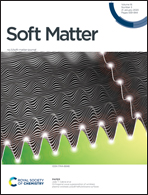Abstract
Exploiting soft, adaptive microgels as building blocks for soft materials with controlled and predictable viscoelastic properties is of great interest for both industry and fundamental research. Here the flow properties of different poly(N-isopropylacrylamide) (pNIPAM) microgels are compared: regularly crosslinked versus ultra-low crosslinked (ULC) microgels. The latter are the softest microgels that can be produced via precipitation polymerization. The viscosity of ULC microgel suspensions at low concentrations can be described with models typically used for hard spheres and regularly crosslinked microgels. In contrast, at higher concentrations, ULC microgels show a much softer behavior compared to regularly crosslinked microgels. The increase of the storage modulus with concentration discloses that while for regularly crosslinked microgels the flow properties are mainly determined by the more crosslinked core, for ULC microgels the brush-like interaction is dominant at high packing fractions. Both the flow curves and the increase of the storage modulus with concentration indicates that ULC microgels can form glass and even reach an apparent jammed state despite their extreme softness. In contrast, the analysis of oscillatory frequency sweep measurements show that when approaching the glass transition the ultra-low crosslinked microgels behave as the regularly crosslinked microgels. This is consistent with a recent study showing that in this concentration range the equilibrium phase behavior of these ULC microgels is the one expected for regularly crosslinked microgels.



 Please wait while we load your content...
Please wait while we load your content...